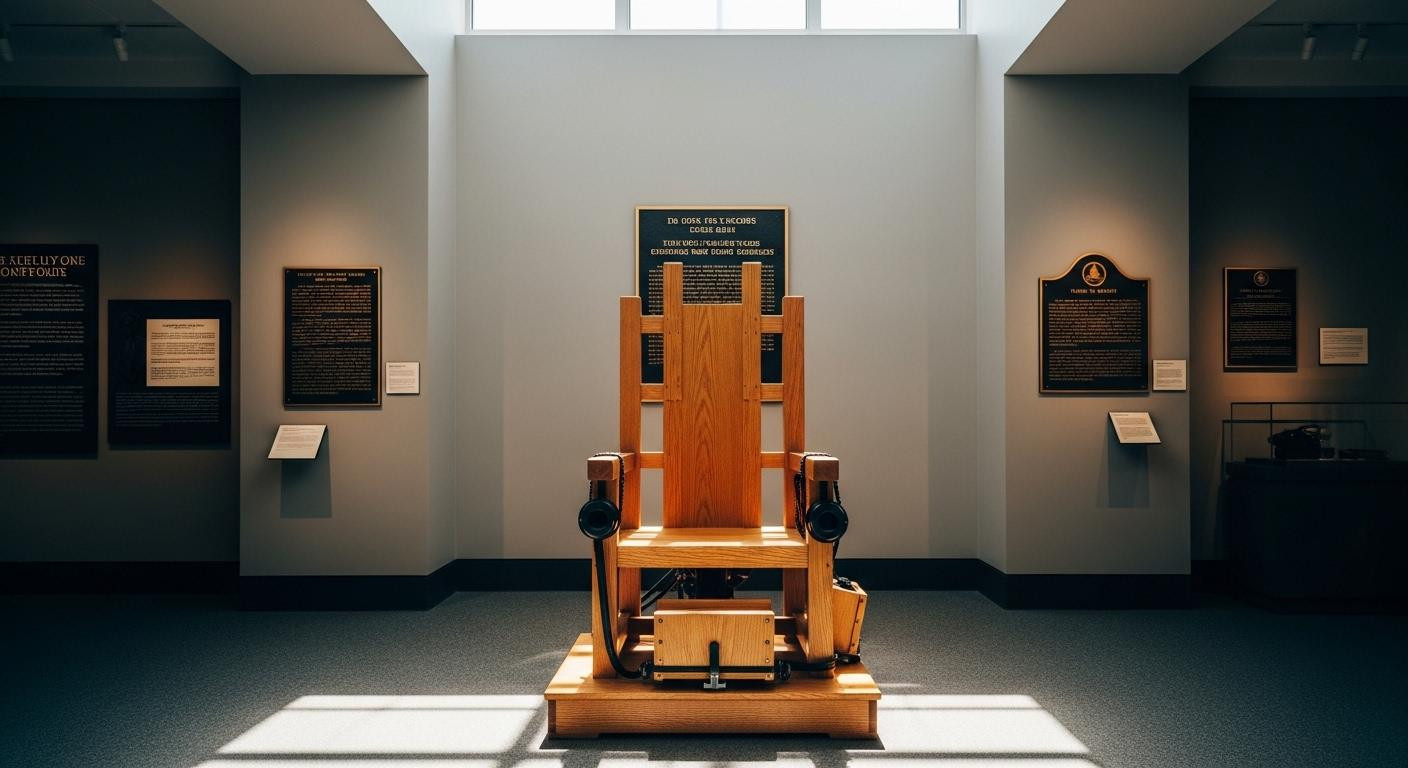Morning light filters through the windows of a modest brick building on Highway 75 North in Huntsville, Texas. Inside, polished oak gleams under museum lighting. This is “Old Sparky,” the electric chair that ended 361 lives between 1924 and 1964. No billboards advertise this place. No tour buses idle outside. While Las Vegas’s Mob Museum charges $50 for sensationalized execution exhibits, Huntsville’s 41,000 residents quietly protect something different: an $8 museum where capital punishment history is preserved with dignity, not spectacle.
The museum Huntsville residents built to educate, not entertain
Drive into Huntsville and you enter “Prison City.” Seven correctional facilities dot this East Texas town. Sam Houston State University’s criminal justice program anchors the community. The Texas Prison Museum sits unassumingly at 491 Highway 75 North, founded in 1989 by former prison employees who wanted authentic documentation, not macabre entertainment.
The museum operates as a nonprofit, completely independent from the Texas Department of Criminal Justice. One full-time employee, several part-time staff, and dedicated volunteers oversee exhibits that trace Texas prison history from 1848 to present. About 34,000 visitors annually discover this educational mission housed in a purpose-built structure from 2002.
What “Old Sparky” reveals about capital punishment evolution
The oak chair that marked a “humane” transition
Hand-carved by incarcerated craftsmen in 1924, “Old Sparky” replaced public hangings with what society deemed more civilized execution. The oak chair features leather restraints and a copper skull cap. It witnessed Texas shift from frontier justice to institutional procedure.
The chair delivered 361 executions over 40 years before lethal injection replaced electrocution in 1964. Small communities like Truth or Consequences preserve quirky history, but Huntsville confronts darker chapters with equal commitment to documentation.
The prison system Texas residents lived alongside
Huntsville’s identity intertwines with corrections. The Walls Unit downtown housed Texas’s execution chamber until 1965. Generations of families worked in the prison system. Museum exhibits demonstrate how execution history shaped local identity without defining it.
Life-size cell replicas show authentic prison conditions. Visitor feedback consistently describes the museum’s honest approach to difficult subject matter. One recent traveler spent nearly 3 hours absorbing exhibits that span from agricultural prison programs to modern correctional methods.
The experience tourists miss and why locals preserve it
Life-size cell replicas and inmate craftsmanship
Beyond “Old Sparky,” visitors walk through reconstructed prison cells. Inmates’ woodwork displays remarkable skill: handcrafted furniture, detailed paintings, even a chess set carved entirely from soap. These artifacts humanize incarceration while documenting institutional history.
The “Escape Clause” exhibit details failed prison breaks. Bonnie Parker’s pistol connects visitors to legendary outlaws. Authentic destinations like these offer genuine historical immersion without commercialized sensationalism.
The stories museum staff share quietly
Museum guides often include former correctional officers and families of prison employees. They share oral histories that official records never captured. Their perspectives transform artifacts from curiosities into educational tools.
The museum environment encourages reflection rather than entertainment. Visitors naturally adopt respectful behavior when confronting capital punishment’s complex legacy. Like Egypt’s new museum presenting Tutankhamun artifacts with cultural reverence, Huntsville prioritizes historical accuracy over tourist appeal.
Why this costs $8 while dark tourism charges $50
The Texas Prison Museum’s admission fees reflect educational mission over commercial profit. Adults pay $8, seniors and military personnel $6, children $7. Group rates drop to $5. Compare this to Alcatraz’s $45 tickets or Eastern State Penitentiary’s $17 admission.
The museum avoids gift shop sensationalism found at commercial dark tourism sites. No electric chair keychains or execution-themed merchandise. While some historic institutions transform into luxury experiences, Huntsville maintains accessible pricing that serves education, not entertainment.
Your Questions About This execution chamber still has the electric chair on display Answered
How do I visit the Texas Prison Museum without crowds?
The museum operates Monday-Saturday 10am-5pm, Sunday noon-5pm. Spring and fall offer ideal weather: 60-80°F temperatures and fewer visitors. Arrive before 11am or after 2pm for solitude. Houston sits 70 miles south, a 90-minute drive. No advance booking required except for groups.
What’s the local perspective on displaying execution equipment?
Huntsville residents view the museum as historical responsibility, not morbid curiosity. Many families have multigenerational ties to the prison system. The museum board includes former wardens and officers who ensure dignified presentation. Local historians emphasize education over sensationalism.
How does this compare to other execution history sites?
Unlike Sing Sing’s oral history focus or Louisiana’s Angola working prison museum, Huntsville preserves actual execution equipment. It’s less theatrical than London’s Tower or Philadelphia’s Mob Museum, more authentic than wax museum recreations. The $8 admission contrasts sharply with commercial dark tourism pricing nationwide.
Afternoon light touches “Old Sparky’s” polished oak surface. The chair that once delivered death now sits silent, witnessing how America confronts its capital punishment past. Outside, Huntsville’s daily life continues, respectful of this history without being haunted by it.
